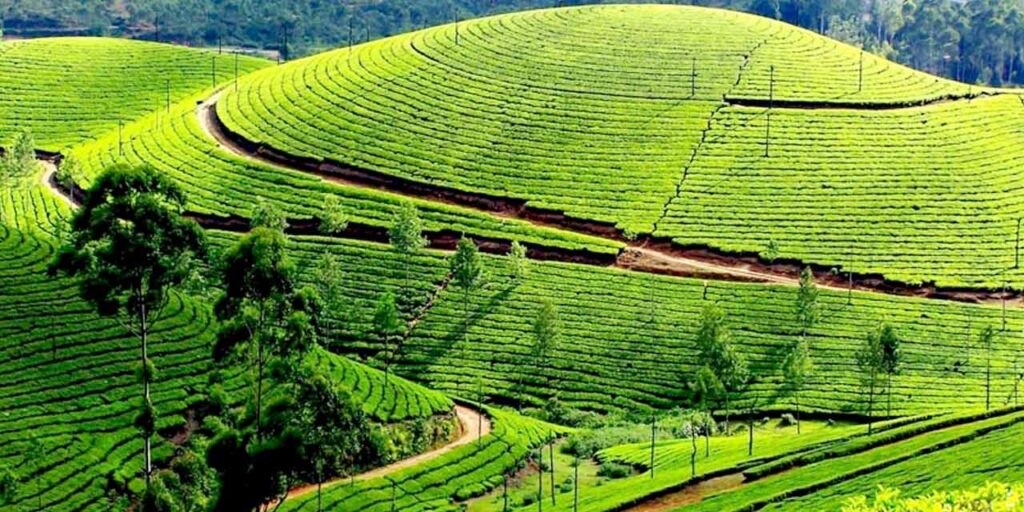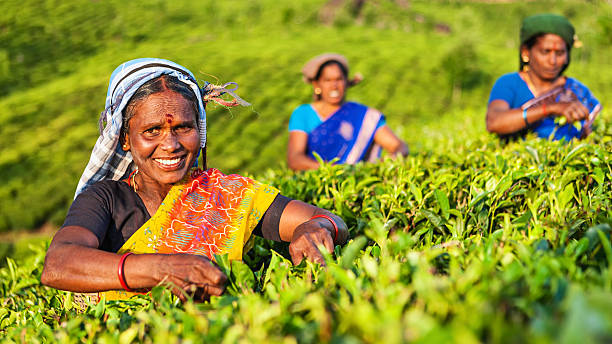Tea Farming in India: A Glimpse into the Green Gold

Tea, often referred to as India’s “green gold,” holds a unique place in the country’s economy, culture, and agricultural landscape. India is one of the largest producers and consumers of tea in the world, contributing significantly to global tea trade. The diverse climate and geography of India make it an ideal destination for cultivating various types of tea, such as Assam, Darjeeling, Nilgiri, and Kangra tea.
Historical Background
Tea cultivation in India began in the early 19th century during British colonial rule. The British established large plantations in Assam and Darjeeling after discovering that the native Camellia sinensis plant could be commercially grown in India. Over the years, India transformed from an importer of Chinese tea to a global exporter and self-sufficient producer.

Climatic and Soil Conditions
Tea thrives in tropical and subtropical climates with abundant rainfall (around 150–250 cm annually), moderate temperatures (10°C to 30°C), and high humidity. Well-drained, slightly acidic soils (pH 4.5–5.5) rich in organic matter are ideal for tea cultivation.
https://sypertimes.com/the-beautiful-and-wild-world-of-the-savanna-grassland/
Major Tea-Producing States in India
1. Assam
- Region: Northeast India
- Contribution: Nearly 50% of India’s total tea production
- Famous Varieties: Assam CTC (Crush, Tear, Curl), Orthodox Assam Tea
Highlights:
Assam is the largest tea-producing region in India and one of the most renowned in the world. The Brahmaputra valley offers fertile alluvial soil and a humid climate, ideal for robust and malty black teas. Tea plantations here are expansive and largely mechanized, with both small growers and large estates.
Challenges: Flooding, labor shortages, and climate change are ongoing issues impacting yields and quality.
2. West Bengal
- Key Regions: Darjeeling, Dooars, Terai
- Famous Varieties: Darjeeling Tea (often called the “Champagne of Teas”)
Highlights:
Darjeeling produces premium quality tea known for its delicate flavor and floral aroma. Located at high altitudes in the Himalayas, Darjeeling tea is grown in terraced plantations. The region produces black, green, white, and oolong teas, highly valued in global markets.
The Dooars and Terai regions, located in the plains, produce CTC teas which are more robust and affordable.
Challenges:
Political instability and aging tea bushes threaten the long-term sustainability of the industry in Darjeeling.
3. Tamil Nadu
- Key Regions: Nilgiris (Blue Mountains)
- Famous Varieties: Nilgiri Tea
Highlights:
The Nilgiri Hills of Tamil Nadu produce aromatic and brisk teas at high altitudes. Tea from this region is used extensively in blends and iced teas due to its strong liquor and bright color. Unlike Assam and Darjeeling, Nilgiri teas are harvested year-round.
Challenges: Land-use competition and unpredictable rainfall patterns.
4. Kerala
- Key Regions: Munnar, Wayanad
- Famous Varieties: Nilgiri-style tea (shared with Tamil Nadu)
Highlights:
Kerala shares the Western Ghats with Tamil Nadu and has similar agro-climatic conditions for tea farming. Munnar is the most famous tea region in Kerala, known for its scenic plantations and eco-tourism potential. Organic farming is gaining popularity here.
Challenges: Environmental concerns and low prices for small farmers.
5. Karnataka
- Key Regions: Chikmagalur, Kodagu (Coorg)
Highlights:
Though not as prominent as Assam or West Bengal, Karnataka’s hill stations offer suitable conditions for tea cultivation. The region is slowly emerging as a center for specialty and organic teas.
6. Himachal Pradesh
- Key Regions: Kangra Valley
- Famous Varieties: Kangra Tea
Highlights:
Kangra tea is known for its light color and unique aroma. The cooler climate of Himachal is suitable for both black and green teas. The government is promoting Kangra tea as a GI (Geographical Indication) product to boost its market presence.
Challenges: Fragmented landholdings and lack of marketing infrastructure.

Types of Tea Grown in India
- Black Tea: Most widely produced; strong flavor, high caffeine.
- Green Tea: Increasing in popularity for health benefits.
- White Tea: Least processed, delicate flavor.
- Oolong Tea: Semi-fermented, unique to Darjeeling and Assam.
- CTC Tea: Economical and commonly used for chai.
Economic Importance
- Employment: The tea industry provides direct employment to over 1 million people, especially women.
- Exports: India exports tea to over 50 countries, with major buyers including Iran, the UAE, Russia, and the UK.
- Revenue: Tea exports contribute significantly to India’s agricultural export revenue.
Challenges in Tea Farming
- Climate Change: Irregular rainfall and temperature changes impact yield and quality.
- Pest and Disease Management: Increasing cases of blight and insect infestations.
- Labor Issues: Low wages and labor shortages affect operations.
- Global Competition: Emerging markets like Kenya and Sri Lanka offer stiff competition.
- Market Fluctuations: Prices are often unstable due to global supply-demand shifts.
Government Support and Research
The Tea Board of India, under the Ministry of Commerce and Industry, plays a key role in promoting tea cultivation through:
- Subsidies for small growers
- Quality certification
- Export facilitation
- Training and research through institutes like the Tea Research Association (TRA) and UPASI Tea Research Institute
Future Prospects
With rising global demand for organic and specialty teas, India has the potential to expand its market share. Value addition through branding (e.g., GI tagging), sustainable practices, and direct-to-consumer marketing (online tea boutiques) could enhance profitability. Integrating tea tourism, especially in regions like Darjeeling, Munnar, and Assam, also offers growth opportunities.

Conclusion
Tea farming in India is more than just an agricultural activity—it’s a cultural heritage, a major livelihood source, and a significant contributor to the economy. Despite facing several challenges, India’s tea industry is resilient and continuously adapting through innovation and sustainability efforts. With appropriate policy support and market alignment, Indian tea can continue to brew success for years to come.




